Assessing alcohol consumption in University Students
VerifiedAdded on 2023/06/09
|9
|2096
|415
AI Summary
This research assesses alcohol consumption in university students through face to face interviews. The themes tested include physiological factors that lead to alcohol abuse, student perception on alcohol drinking, and consequences of alcohol abuse.
Contribute Materials
Your contribution can guide someone’s learning journey. Share your
documents today.
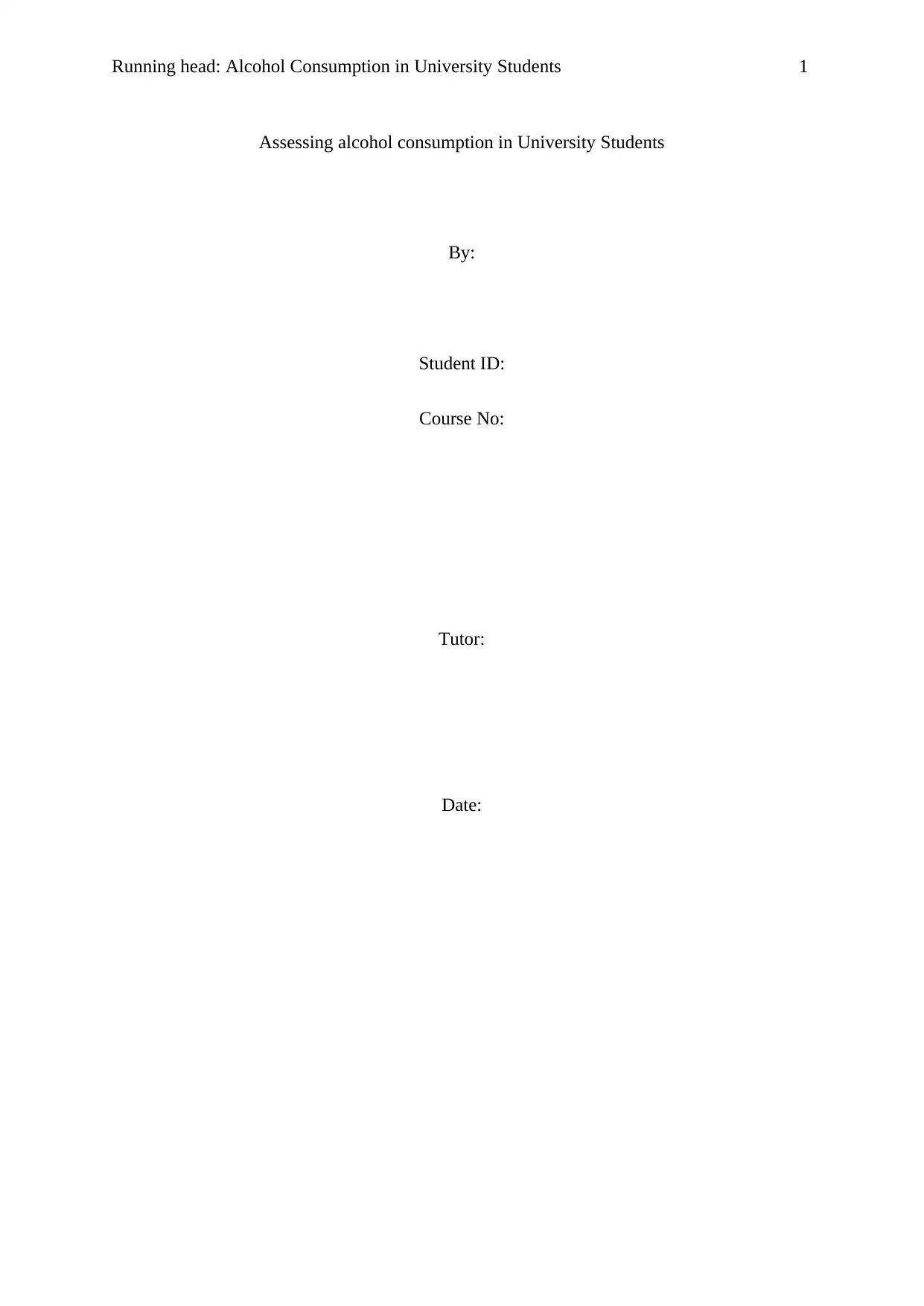
Running head: Alcohol Consumption in University Students 1
Assessing alcohol consumption in University Students
By:
Student ID:
Course No:
Tutor:
Date:
Assessing alcohol consumption in University Students
By:
Student ID:
Course No:
Tutor:
Date:
Secure Best Marks with AI Grader
Need help grading? Try our AI Grader for instant feedback on your assignments.

Alcohol Consumption in University Students 2
Table of Contents
1.0 Reflection on the Interview Technique............................................................................3
2.0 Coding and Theming..........................................................................................................4
2.1 Physiological factors that lead to alcohol abuse...........................................................4
2.2 Student perception on alcohol drinking.......................................................................5
2.3 Consequences of alcohol abuse......................................................................................6
References.................................................................................................................................8
Table of Contents
1.0 Reflection on the Interview Technique............................................................................3
2.0 Coding and Theming..........................................................................................................4
2.1 Physiological factors that lead to alcohol abuse...........................................................4
2.2 Student perception on alcohol drinking.......................................................................5
2.3 Consequences of alcohol abuse......................................................................................6
References.................................................................................................................................8
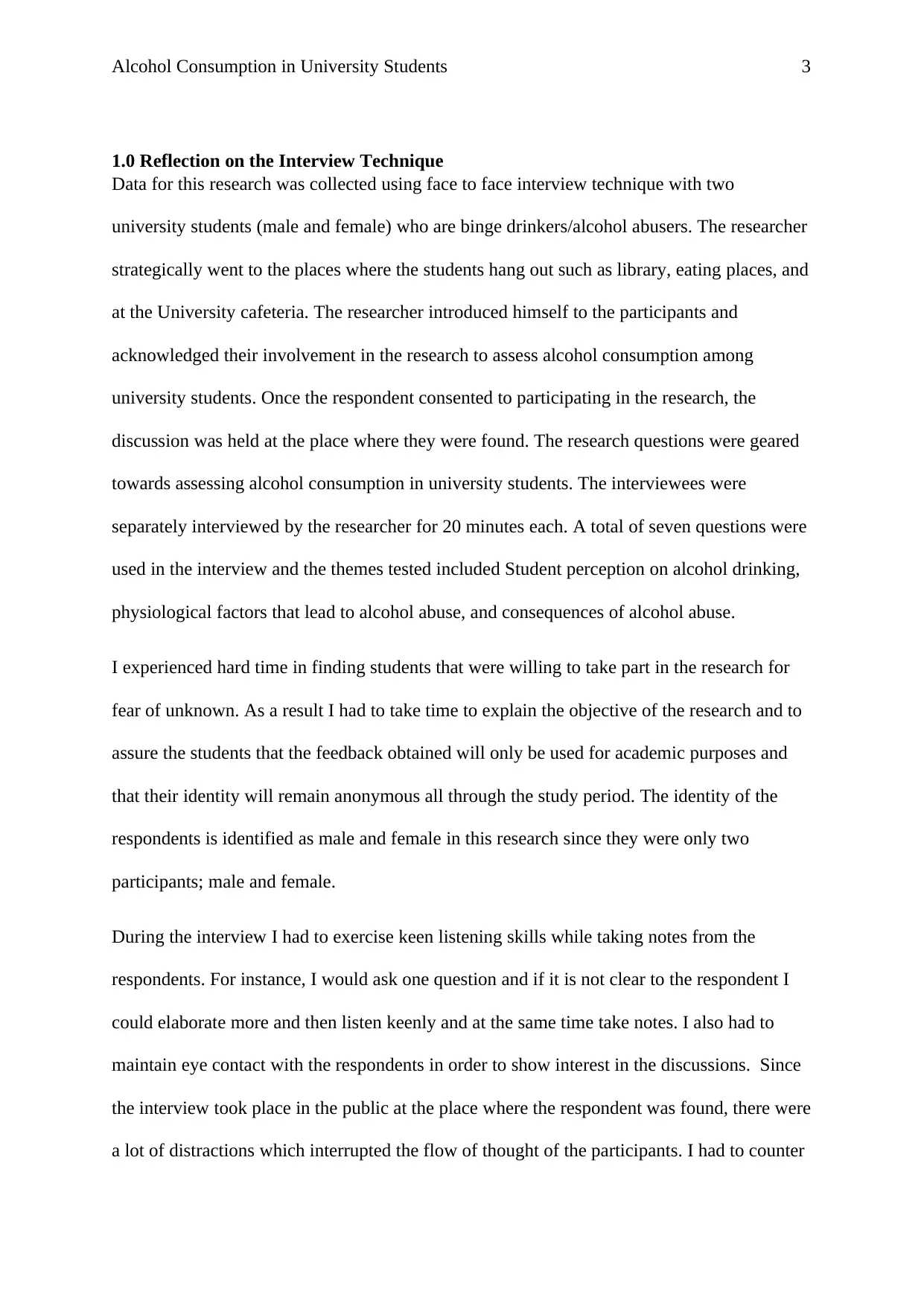
Alcohol Consumption in University Students 3
1.0 Reflection on the Interview Technique
Data for this research was collected using face to face interview technique with two
university students (male and female) who are binge drinkers/alcohol abusers. The researcher
strategically went to the places where the students hang out such as library, eating places, and
at the University cafeteria. The researcher introduced himself to the participants and
acknowledged their involvement in the research to assess alcohol consumption among
university students. Once the respondent consented to participating in the research, the
discussion was held at the place where they were found. The research questions were geared
towards assessing alcohol consumption in university students. The interviewees were
separately interviewed by the researcher for 20 minutes each. A total of seven questions were
used in the interview and the themes tested included Student perception on alcohol drinking,
physiological factors that lead to alcohol abuse, and consequences of alcohol abuse.
I experienced hard time in finding students that were willing to take part in the research for
fear of unknown. As a result I had to take time to explain the objective of the research and to
assure the students that the feedback obtained will only be used for academic purposes and
that their identity will remain anonymous all through the study period. The identity of the
respondents is identified as male and female in this research since they were only two
participants; male and female.
During the interview I had to exercise keen listening skills while taking notes from the
respondents. For instance, I would ask one question and if it is not clear to the respondent I
could elaborate more and then listen keenly and at the same time take notes. I also had to
maintain eye contact with the respondents in order to show interest in the discussions. Since
the interview took place in the public at the place where the respondent was found, there were
a lot of distractions which interrupted the flow of thought of the participants. I had to counter
1.0 Reflection on the Interview Technique
Data for this research was collected using face to face interview technique with two
university students (male and female) who are binge drinkers/alcohol abusers. The researcher
strategically went to the places where the students hang out such as library, eating places, and
at the University cafeteria. The researcher introduced himself to the participants and
acknowledged their involvement in the research to assess alcohol consumption among
university students. Once the respondent consented to participating in the research, the
discussion was held at the place where they were found. The research questions were geared
towards assessing alcohol consumption in university students. The interviewees were
separately interviewed by the researcher for 20 minutes each. A total of seven questions were
used in the interview and the themes tested included Student perception on alcohol drinking,
physiological factors that lead to alcohol abuse, and consequences of alcohol abuse.
I experienced hard time in finding students that were willing to take part in the research for
fear of unknown. As a result I had to take time to explain the objective of the research and to
assure the students that the feedback obtained will only be used for academic purposes and
that their identity will remain anonymous all through the study period. The identity of the
respondents is identified as male and female in this research since they were only two
participants; male and female.
During the interview I had to exercise keen listening skills while taking notes from the
respondents. For instance, I would ask one question and if it is not clear to the respondent I
could elaborate more and then listen keenly and at the same time take notes. I also had to
maintain eye contact with the respondents in order to show interest in the discussions. Since
the interview took place in the public at the place where the respondent was found, there were
a lot of distractions which interrupted the flow of thought of the participants. I had to counter
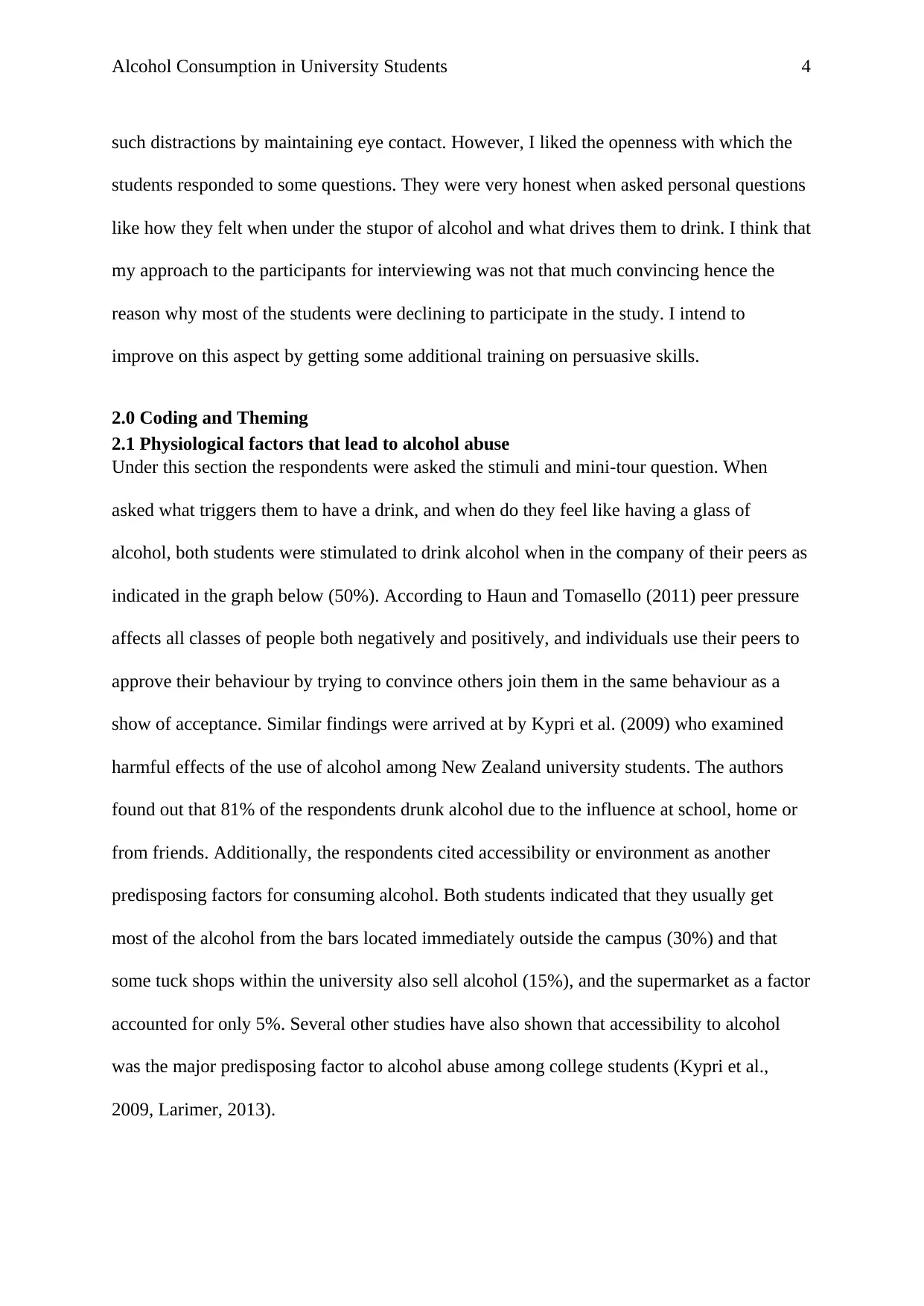
Alcohol Consumption in University Students 4
such distractions by maintaining eye contact. However, I liked the openness with which the
students responded to some questions. They were very honest when asked personal questions
like how they felt when under the stupor of alcohol and what drives them to drink. I think that
my approach to the participants for interviewing was not that much convincing hence the
reason why most of the students were declining to participate in the study. I intend to
improve on this aspect by getting some additional training on persuasive skills.
2.0 Coding and Theming
2.1 Physiological factors that lead to alcohol abuse
Under this section the respondents were asked the stimuli and mini-tour question. When
asked what triggers them to have a drink, and when do they feel like having a glass of
alcohol, both students were stimulated to drink alcohol when in the company of their peers as
indicated in the graph below (50%). According to Haun and Tomasello (2011) peer pressure
affects all classes of people both negatively and positively, and individuals use their peers to
approve their behaviour by trying to convince others join them in the same behaviour as a
show of acceptance. Similar findings were arrived at by Kypri et al. (2009) who examined
harmful effects of the use of alcohol among New Zealand university students. The authors
found out that 81% of the respondents drunk alcohol due to the influence at school, home or
from friends. Additionally, the respondents cited accessibility or environment as another
predisposing factors for consuming alcohol. Both students indicated that they usually get
most of the alcohol from the bars located immediately outside the campus (30%) and that
some tuck shops within the university also sell alcohol (15%), and the supermarket as a factor
accounted for only 5%. Several other studies have also shown that accessibility to alcohol
was the major predisposing factor to alcohol abuse among college students (Kypri et al.,
2009, Larimer, 2013).
such distractions by maintaining eye contact. However, I liked the openness with which the
students responded to some questions. They were very honest when asked personal questions
like how they felt when under the stupor of alcohol and what drives them to drink. I think that
my approach to the participants for interviewing was not that much convincing hence the
reason why most of the students were declining to participate in the study. I intend to
improve on this aspect by getting some additional training on persuasive skills.
2.0 Coding and Theming
2.1 Physiological factors that lead to alcohol abuse
Under this section the respondents were asked the stimuli and mini-tour question. When
asked what triggers them to have a drink, and when do they feel like having a glass of
alcohol, both students were stimulated to drink alcohol when in the company of their peers as
indicated in the graph below (50%). According to Haun and Tomasello (2011) peer pressure
affects all classes of people both negatively and positively, and individuals use their peers to
approve their behaviour by trying to convince others join them in the same behaviour as a
show of acceptance. Similar findings were arrived at by Kypri et al. (2009) who examined
harmful effects of the use of alcohol among New Zealand university students. The authors
found out that 81% of the respondents drunk alcohol due to the influence at school, home or
from friends. Additionally, the respondents cited accessibility or environment as another
predisposing factors for consuming alcohol. Both students indicated that they usually get
most of the alcohol from the bars located immediately outside the campus (30%) and that
some tuck shops within the university also sell alcohol (15%), and the supermarket as a factor
accounted for only 5%. Several other studies have also shown that accessibility to alcohol
was the major predisposing factor to alcohol abuse among college students (Kypri et al.,
2009, Larimer, 2013).
Secure Best Marks with AI Grader
Need help grading? Try our AI Grader for instant feedback on your assignments.
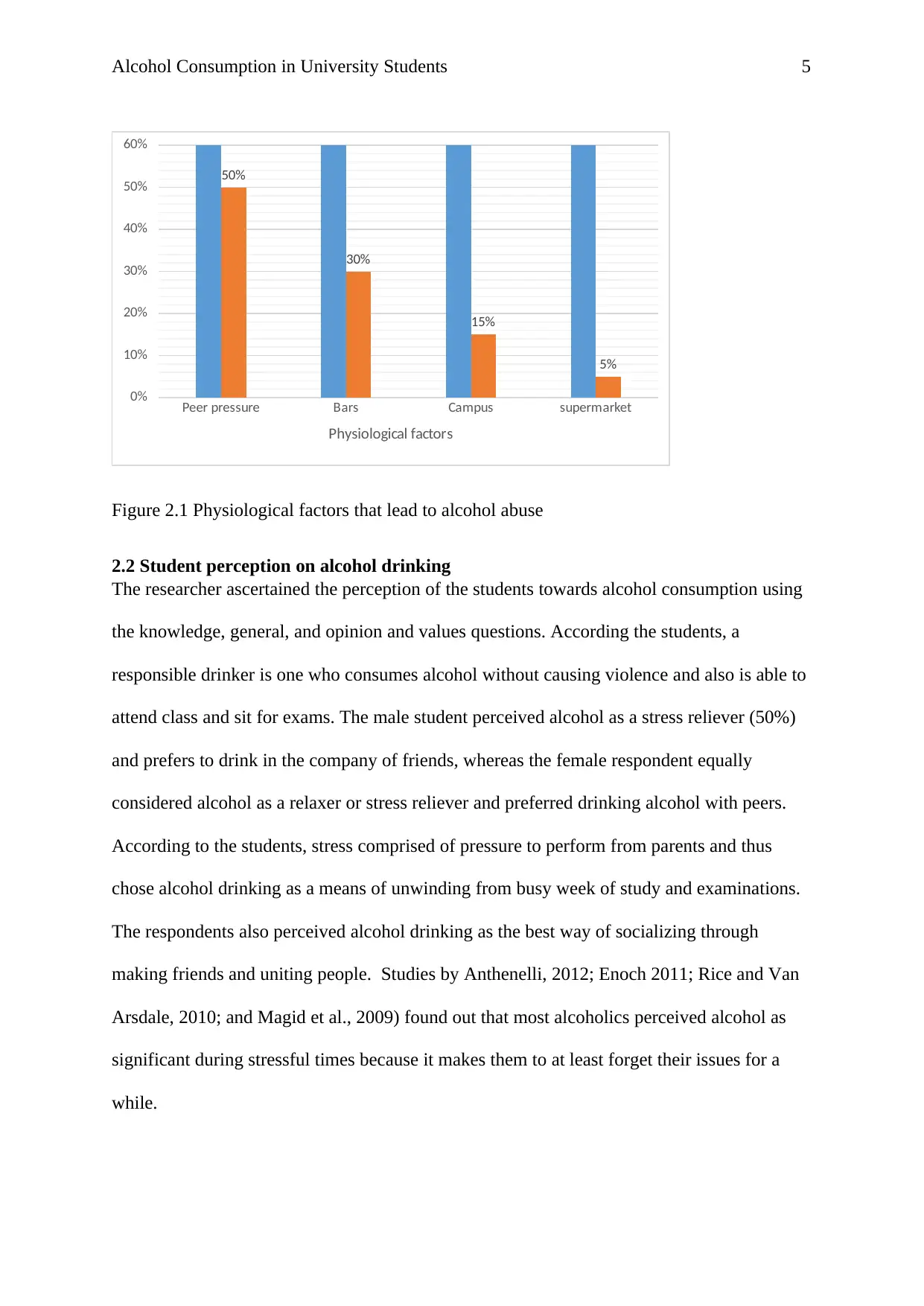
Alcohol Consumption in University Students 5
Peer pressure Bars Campus supermarket
0%
10%
20%
30%
40%
50%
60%
50%
30%
15%
5%
Physiological factors
Figure 2.1 Physiological factors that lead to alcohol abuse
2.2 Student perception on alcohol drinking
The researcher ascertained the perception of the students towards alcohol consumption using
the knowledge, general, and opinion and values questions. According the students, a
responsible drinker is one who consumes alcohol without causing violence and also is able to
attend class and sit for exams. The male student perceived alcohol as a stress reliever (50%)
and prefers to drink in the company of friends, whereas the female respondent equally
considered alcohol as a relaxer or stress reliever and preferred drinking alcohol with peers.
According to the students, stress comprised of pressure to perform from parents and thus
chose alcohol drinking as a means of unwinding from busy week of study and examinations.
The respondents also perceived alcohol drinking as the best way of socializing through
making friends and uniting people. Studies by Anthenelli, 2012; Enoch 2011; Rice and Van
Arsdale, 2010; and Magid et al., 2009) found out that most alcoholics perceived alcohol as
significant during stressful times because it makes them to at least forget their issues for a
while.
Peer pressure Bars Campus supermarket
0%
10%
20%
30%
40%
50%
60%
50%
30%
15%
5%
Physiological factors
Figure 2.1 Physiological factors that lead to alcohol abuse
2.2 Student perception on alcohol drinking
The researcher ascertained the perception of the students towards alcohol consumption using
the knowledge, general, and opinion and values questions. According the students, a
responsible drinker is one who consumes alcohol without causing violence and also is able to
attend class and sit for exams. The male student perceived alcohol as a stress reliever (50%)
and prefers to drink in the company of friends, whereas the female respondent equally
considered alcohol as a relaxer or stress reliever and preferred drinking alcohol with peers.
According to the students, stress comprised of pressure to perform from parents and thus
chose alcohol drinking as a means of unwinding from busy week of study and examinations.
The respondents also perceived alcohol drinking as the best way of socializing through
making friends and uniting people. Studies by Anthenelli, 2012; Enoch 2011; Rice and Van
Arsdale, 2010; and Magid et al., 2009) found out that most alcoholics perceived alcohol as
significant during stressful times because it makes them to at least forget their issues for a
while.

Alcohol Consumption in University Students 6
Who is a responsible drinker
Percentag
e
Drinks without violence 50%
Drinks but still goes to class 50%
Total 100%
How do you unwind after busy week?
Percentag
e
Stress reliever 50%
In company of friends 50%
Total 100%
views on alcohol and socializing with
people
Percentag
e
Alcohol unites 50%
Alcohol makes friends 50%
Total 100%
Table 2.2 Student perception on alcohol drinking
2.3 Consequences of alcohol abuse
The consequences of alcohol abuse were examined from the students by asking them
questions on feelings, and experience or behaviour after drinking alcohol. The findings
indicated that both students experienced physical aggression (15%) when drunk. These
findings are also supported by those of Parks, Hsieh, Bradizza, and Romosz, 2008; Foran,
and O'Leary, 2008) who examined the relationship between alcohol and human aggression
and found out that there was a positive correlation between aggressive behaviour and alcohol
Who is a responsible drinker
Percentag
e
Drinks without violence 50%
Drinks but still goes to class 50%
Total 100%
How do you unwind after busy week?
Percentag
e
Stress reliever 50%
In company of friends 50%
Total 100%
views on alcohol and socializing with
people
Percentag
e
Alcohol unites 50%
Alcohol makes friends 50%
Total 100%
Table 2.2 Student perception on alcohol drinking
2.3 Consequences of alcohol abuse
The consequences of alcohol abuse were examined from the students by asking them
questions on feelings, and experience or behaviour after drinking alcohol. The findings
indicated that both students experienced physical aggression (15%) when drunk. These
findings are also supported by those of Parks, Hsieh, Bradizza, and Romosz, 2008; Foran,
and O'Leary, 2008) who examined the relationship between alcohol and human aggression
and found out that there was a positive correlation between aggressive behaviour and alcohol
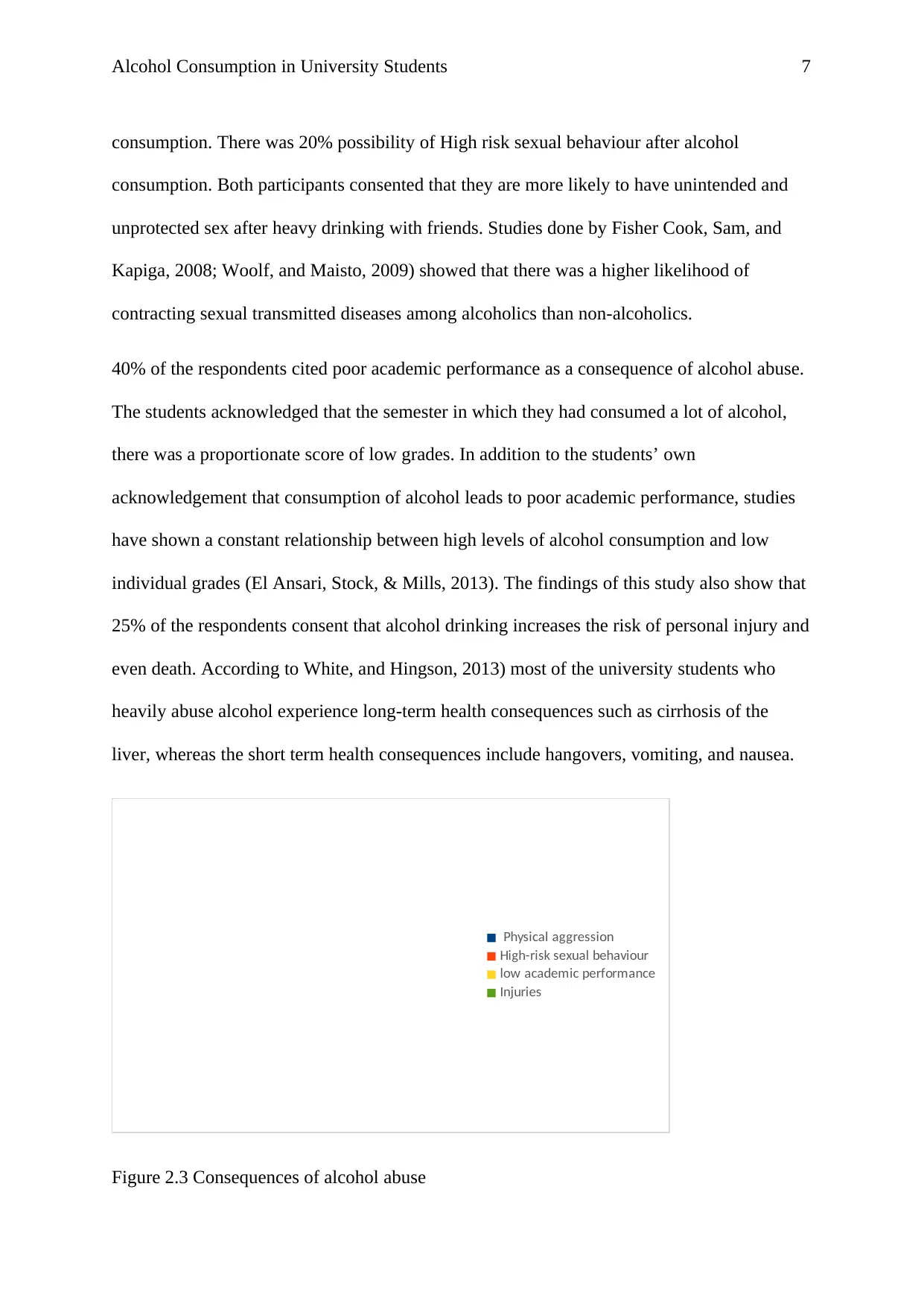
Alcohol Consumption in University Students 7
consumption. There was 20% possibility of High risk sexual behaviour after alcohol
consumption. Both participants consented that they are more likely to have unintended and
unprotected sex after heavy drinking with friends. Studies done by Fisher Cook, Sam, and
Kapiga, 2008; Woolf, and Maisto, 2009) showed that there was a higher likelihood of
contracting sexual transmitted diseases among alcoholics than non-alcoholics.
40% of the respondents cited poor academic performance as a consequence of alcohol abuse.
The students acknowledged that the semester in which they had consumed a lot of alcohol,
there was a proportionate score of low grades. In addition to the students’ own
acknowledgement that consumption of alcohol leads to poor academic performance, studies
have shown a constant relationship between high levels of alcohol consumption and low
individual grades (El Ansari, Stock, & Mills, 2013). The findings of this study also show that
25% of the respondents consent that alcohol drinking increases the risk of personal injury and
even death. According to White, and Hingson, 2013) most of the university students who
heavily abuse alcohol experience long-term health consequences such as cirrhosis of the
liver, whereas the short term health consequences include hangovers, vomiting, and nausea.
Physical aggression
High-risk sexual behaviour
low academic performance
Injuries
Figure 2.3 Consequences of alcohol abuse
consumption. There was 20% possibility of High risk sexual behaviour after alcohol
consumption. Both participants consented that they are more likely to have unintended and
unprotected sex after heavy drinking with friends. Studies done by Fisher Cook, Sam, and
Kapiga, 2008; Woolf, and Maisto, 2009) showed that there was a higher likelihood of
contracting sexual transmitted diseases among alcoholics than non-alcoholics.
40% of the respondents cited poor academic performance as a consequence of alcohol abuse.
The students acknowledged that the semester in which they had consumed a lot of alcohol,
there was a proportionate score of low grades. In addition to the students’ own
acknowledgement that consumption of alcohol leads to poor academic performance, studies
have shown a constant relationship between high levels of alcohol consumption and low
individual grades (El Ansari, Stock, & Mills, 2013). The findings of this study also show that
25% of the respondents consent that alcohol drinking increases the risk of personal injury and
even death. According to White, and Hingson, 2013) most of the university students who
heavily abuse alcohol experience long-term health consequences such as cirrhosis of the
liver, whereas the short term health consequences include hangovers, vomiting, and nausea.
Physical aggression
High-risk sexual behaviour
low academic performance
Injuries
Figure 2.3 Consequences of alcohol abuse
Paraphrase This Document
Need a fresh take? Get an instant paraphrase of this document with our AI Paraphraser
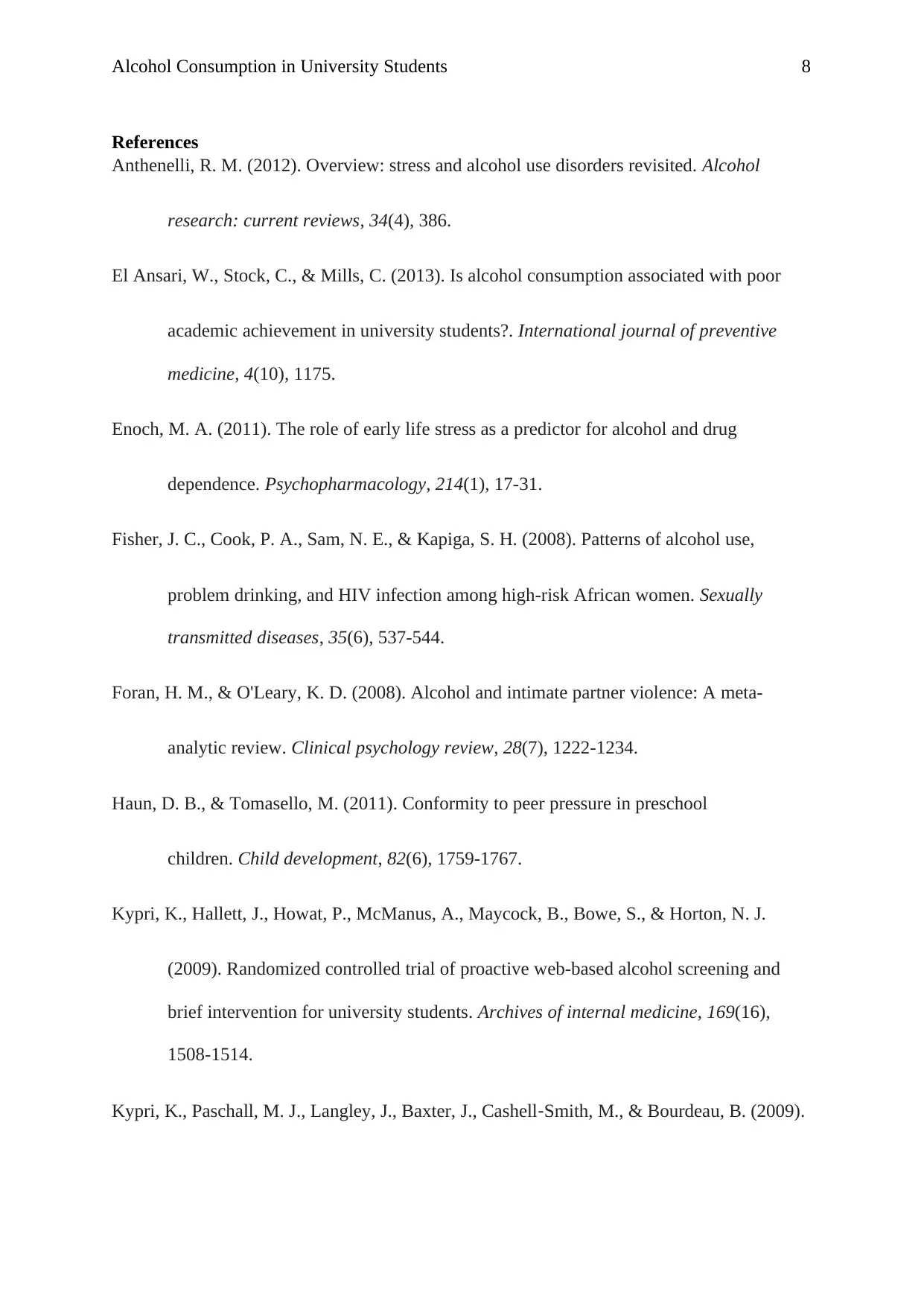
Alcohol Consumption in University Students 8
References
Anthenelli, R. M. (2012). Overview: stress and alcohol use disorders revisited. Alcohol
research: current reviews, 34(4), 386.
El Ansari, W., Stock, C., & Mills, C. (2013). Is alcohol consumption associated with poor
academic achievement in university students?. International journal of preventive
medicine, 4(10), 1175.
Enoch, M. A. (2011). The role of early life stress as a predictor for alcohol and drug
dependence. Psychopharmacology, 214(1), 17-31.
Fisher, J. C., Cook, P. A., Sam, N. E., & Kapiga, S. H. (2008). Patterns of alcohol use,
problem drinking, and HIV infection among high-risk African women. Sexually
transmitted diseases, 35(6), 537-544.
Foran, H. M., & O'Leary, K. D. (2008). Alcohol and intimate partner violence: A meta-
analytic review. Clinical psychology review, 28(7), 1222-1234.
Haun, D. B., & Tomasello, M. (2011). Conformity to peer pressure in preschool
children. Child development, 82(6), 1759-1767.
Kypri, K., Hallett, J., Howat, P., McManus, A., Maycock, B., Bowe, S., & Horton, N. J.
(2009). Randomized controlled trial of proactive web-based alcohol screening and
brief intervention for university students. Archives of internal medicine, 169(16),
1508-1514.
Kypri, K., Paschall, M. J., Langley, J., Baxter, J., Cashell‐Smith, M., & Bourdeau, B. (2009).
References
Anthenelli, R. M. (2012). Overview: stress and alcohol use disorders revisited. Alcohol
research: current reviews, 34(4), 386.
El Ansari, W., Stock, C., & Mills, C. (2013). Is alcohol consumption associated with poor
academic achievement in university students?. International journal of preventive
medicine, 4(10), 1175.
Enoch, M. A. (2011). The role of early life stress as a predictor for alcohol and drug
dependence. Psychopharmacology, 214(1), 17-31.
Fisher, J. C., Cook, P. A., Sam, N. E., & Kapiga, S. H. (2008). Patterns of alcohol use,
problem drinking, and HIV infection among high-risk African women. Sexually
transmitted diseases, 35(6), 537-544.
Foran, H. M., & O'Leary, K. D. (2008). Alcohol and intimate partner violence: A meta-
analytic review. Clinical psychology review, 28(7), 1222-1234.
Haun, D. B., & Tomasello, M. (2011). Conformity to peer pressure in preschool
children. Child development, 82(6), 1759-1767.
Kypri, K., Hallett, J., Howat, P., McManus, A., Maycock, B., Bowe, S., & Horton, N. J.
(2009). Randomized controlled trial of proactive web-based alcohol screening and
brief intervention for university students. Archives of internal medicine, 169(16),
1508-1514.
Kypri, K., Paschall, M. J., Langley, J., Baxter, J., Cashell‐Smith, M., & Bourdeau, B. (2009).
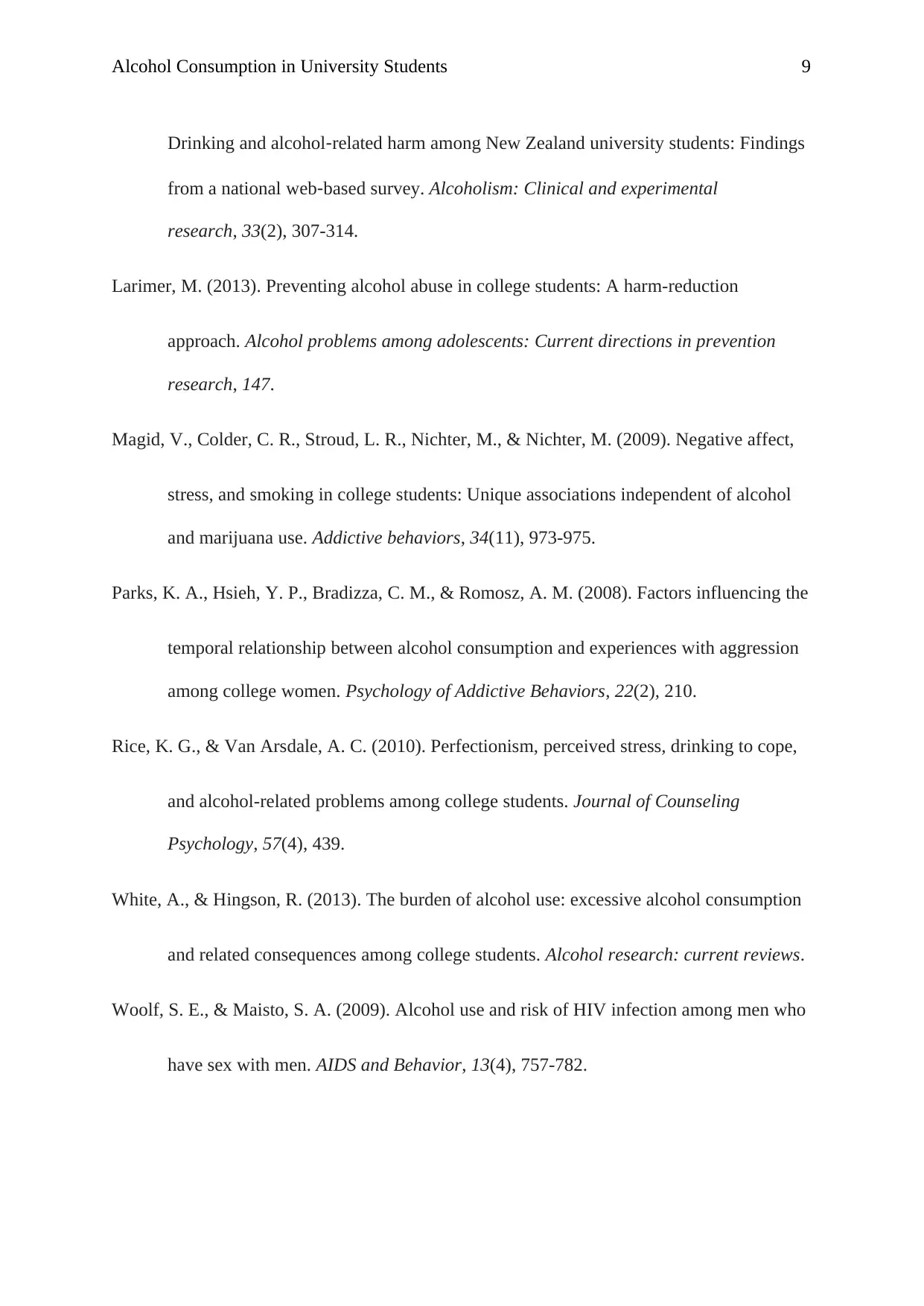
Alcohol Consumption in University Students 9
Drinking and alcohol‐related harm among New Zealand university students: Findings
from a national web‐based survey. Alcoholism: Clinical and experimental
research, 33(2), 307-314.
Larimer, M. (2013). Preventing alcohol abuse in college students: A harm-reduction
approach. Alcohol problems among adolescents: Current directions in prevention
research, 147.
Magid, V., Colder, C. R., Stroud, L. R., Nichter, M., & Nichter, M. (2009). Negative affect,
stress, and smoking in college students: Unique associations independent of alcohol
and marijuana use. Addictive behaviors, 34(11), 973-975.
Parks, K. A., Hsieh, Y. P., Bradizza, C. M., & Romosz, A. M. (2008). Factors influencing the
temporal relationship between alcohol consumption and experiences with aggression
among college women. Psychology of Addictive Behaviors, 22(2), 210.
Rice, K. G., & Van Arsdale, A. C. (2010). Perfectionism, perceived stress, drinking to cope,
and alcohol-related problems among college students. Journal of Counseling
Psychology, 57(4), 439.
White, A., & Hingson, R. (2013). The burden of alcohol use: excessive alcohol consumption
and related consequences among college students. Alcohol research: current reviews.
Woolf, S. E., & Maisto, S. A. (2009). Alcohol use and risk of HIV infection among men who
have sex with men. AIDS and Behavior, 13(4), 757-782.
Drinking and alcohol‐related harm among New Zealand university students: Findings
from a national web‐based survey. Alcoholism: Clinical and experimental
research, 33(2), 307-314.
Larimer, M. (2013). Preventing alcohol abuse in college students: A harm-reduction
approach. Alcohol problems among adolescents: Current directions in prevention
research, 147.
Magid, V., Colder, C. R., Stroud, L. R., Nichter, M., & Nichter, M. (2009). Negative affect,
stress, and smoking in college students: Unique associations independent of alcohol
and marijuana use. Addictive behaviors, 34(11), 973-975.
Parks, K. A., Hsieh, Y. P., Bradizza, C. M., & Romosz, A. M. (2008). Factors influencing the
temporal relationship between alcohol consumption and experiences with aggression
among college women. Psychology of Addictive Behaviors, 22(2), 210.
Rice, K. G., & Van Arsdale, A. C. (2010). Perfectionism, perceived stress, drinking to cope,
and alcohol-related problems among college students. Journal of Counseling
Psychology, 57(4), 439.
White, A., & Hingson, R. (2013). The burden of alcohol use: excessive alcohol consumption
and related consequences among college students. Alcohol research: current reviews.
Woolf, S. E., & Maisto, S. A. (2009). Alcohol use and risk of HIV infection among men who
have sex with men. AIDS and Behavior, 13(4), 757-782.
1 out of 9
Related Documents
Your All-in-One AI-Powered Toolkit for Academic Success.
+13062052269
info@desklib.com
Available 24*7 on WhatsApp / Email
![[object Object]](/_next/static/media/star-bottom.7253800d.svg)
Unlock your academic potential
© 2024 | Zucol Services PVT LTD | All rights reserved.





